The art of calligraphy, as I have already
observed, in the hands of artists from the East, is truly magnificent,
a real poem, which is far removed from considerations of quality and meaning.
The remarkable thing is that Kilessopoulos produces exactly the same type
of sensation as this style of writing. His grammography, in the calligraphic
sense, is of an exceptional quality. This quality has a special characteristic:
if one looks at a lot of these works and imagines isolating a small section
and magnifying it, one will observe that the magnified section possesses
the same quality as the original one. This is a basic property of fractals:
a shape, however many times it is magnified, will retain its original form.
This is an innate property of the shape, which somehow multiplies itself
and creates a sense of dimension. We are familiar with whole dimensions:
a line has one dimension, a surface two, a volume three. In fractals
we have intermediate states: 2, 17, 3, 24 etc.
The interesting thing is that in Kilessopoulos's
grammography both the element of self-similarity and the element of quality
of line are to be found, which is quite remarkable.
Whenever the basic graphic element in
his drawings is the dot - whenever, that is, we have an "image" created
exclusively by stippling - it is the density of the dots that creates various
shapes, such as oblongs, linear forms, spirals etc. Such shapes, I would
say, are commonplace in astronomy nowadays, for they use them in order
to understand the large structures of the universe by representing huge
numbers of galactic formations, which are actually being confirmed by the
latest telescopes. Kilessopoulos's tendency to create similar images in
his paintings, images of course that he has never seen, nor has scientific
knowledge of, in my opinion displays not only artistic intuition but also
represents an intellectual impulse to record structures which consist of
dots or blobs in different concentrations. For me, an original feature
of his work is the fact that the geometry of the very shapes he uses coincides
with that of the formations in the universe, and this happens because he
possesses a knowledge of the aesthetics of these basic formations. Thus
his work acquires aesthetic meaning while at the same time balancing out
various forces, each of which tends to have a different aim and move in
a different direction. It is the authenticity of the geometric basis of
his painting that brings him, as a creator, closer to Nature and to conquering
her structures.
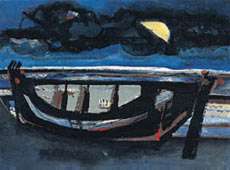 |
| Boats,
series 1964-1974 |
|
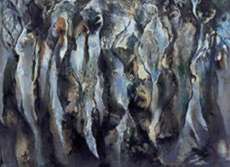 |
| Forest,
1976 |
|
|
Each individual
section of one of his paintings, be it large or small, as well as the final
composition, expresses the philosophy of life and outlook which underlie
the picture. And the variety is huge: you look at two pictures from the
same period and the same cycle - for example, "Cosmic Landscapes" or "The
Plutonic Series" - and they are quite different from each other.
Nevertheless, within this great variety there is unity and that is a remarkable
achievement.
There is a series of boats painted between
'64 and '74 in the style mastered by Braque, with whose boats I have no
hesitation in comparing them. In one sense, the '60s are dominated by the
spirit of Braque and Picasso. The use of colour to cover a surface is masterly
and the general composition perfect. Brown colours prevail during this
period - and only this one - and give me an impression of bronze.
In the work entitled "Forest" (1976) there
is not simply a mixture of human figures and trees, nor does it concern
me whether the figures can be recognized as trees or humans. In this work,
which in my opinion is one of the most representative of this period, what
concerns me is the relationship between form and colour, which is carried
to lofty heights of expression. |
During the '70s what I find most interesting
is the "Cosmic Landscapes" series: these are the works I like most of all
and represent some of the very best work that Kilessopoulos has created.
As has been noted by others, these contain a sense of Music. Personally,
I think that Geography and Astronomy play a greater role in both the conception
and the execution, not as Sciences but as outlooks on life. Looking at
the picture "Inferno", I believe that it should stand for Dante's Divina
Commedia. Another achievement of this period is "Fire" (1982), with the
unique way in which the fire, the red, the fiery red spreads over the cool
blue.
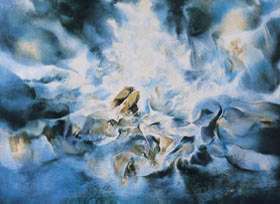 |
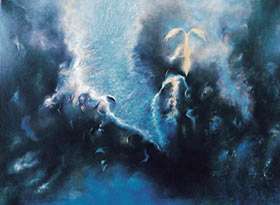
Cosmic
Landscapes series |
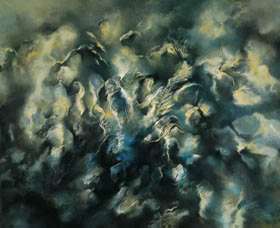
Inferno |
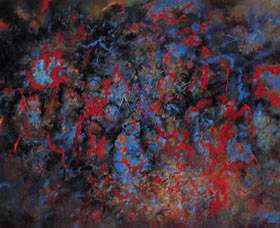
Fire,
1982 |
|
|
On the inside covers of the album containing
his works from the period 1988-1991, on facing pages, are displayed the
positive and negative images of stippled drawings which are not simply
identical views of the same image placed side by side but mirror reflections
of each other, so that what can be seen in the right-hand section of one
appears in the left-hand section of the other, and vice versa. Both the
"positive" and the "negative" versions are totally convincing as complete
works in their own right. We have here the element of reversibility, something
which tempts me to draw another comparison with Bach, this time with his
contrapuntal fugues. These require the use of many rules of counterpoint,
with the result that the most complicated combination of rules produces
greater musical interest and the counterpoint creates another, magical
world. A similar type of magic is created by Kilessopoulos's contrapuntal
drawings. On the other hand, the serial method - an extension of the 12-note
system devised after the Second World War - produced works of a completely
random nature because the composers could not control the result, unlike
Bach, who definitely could.
|